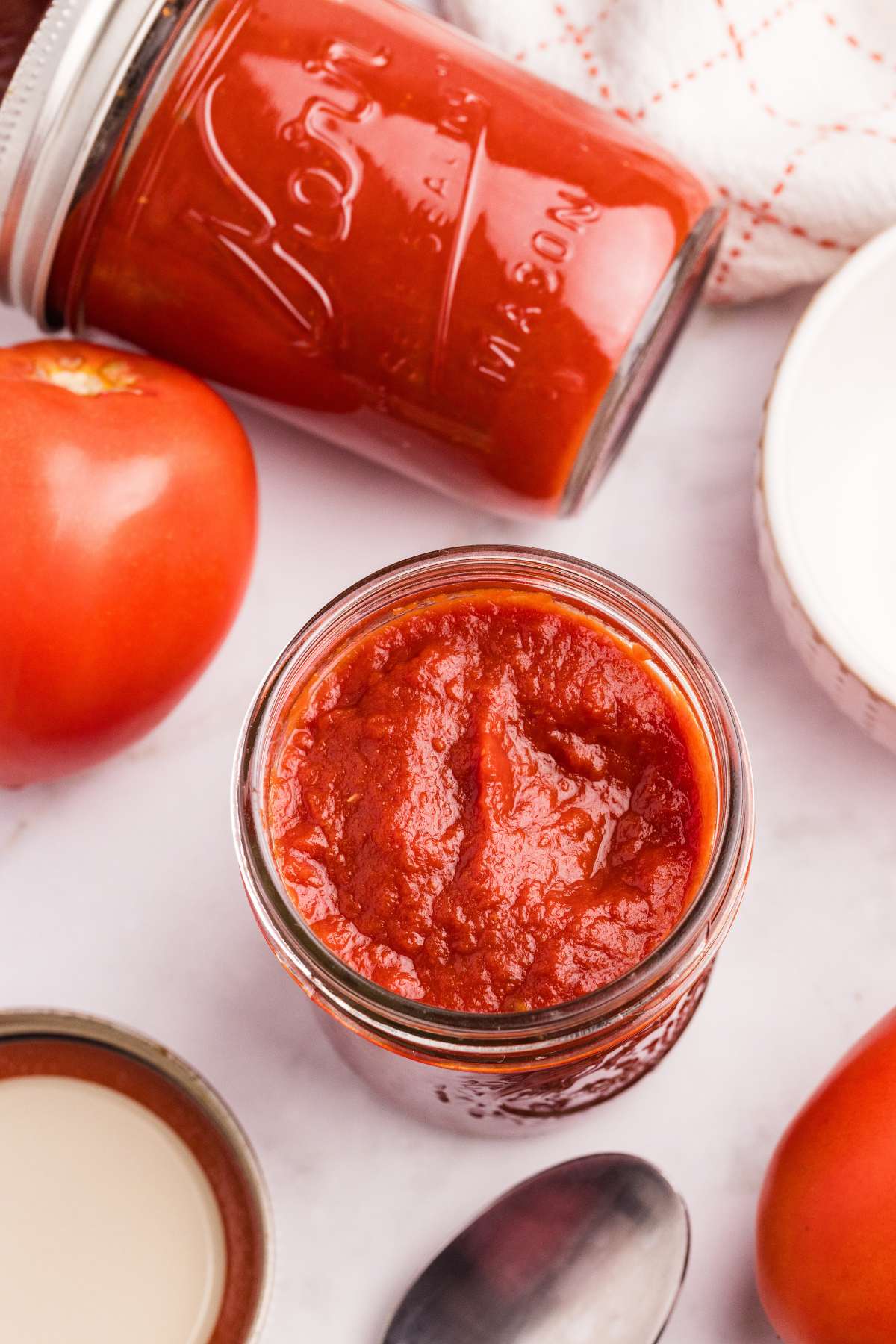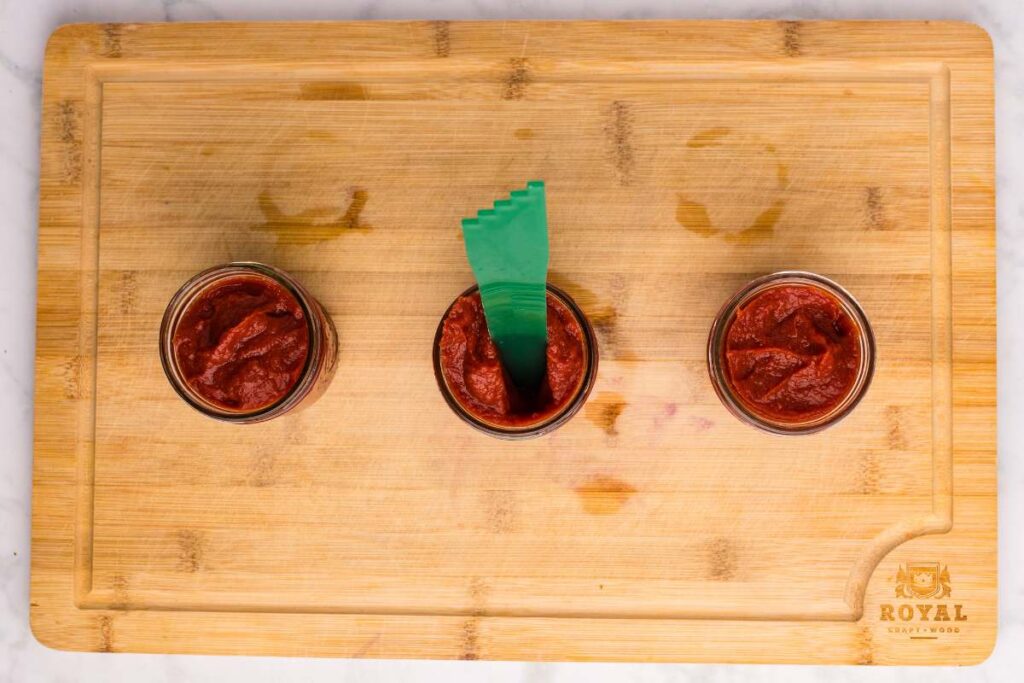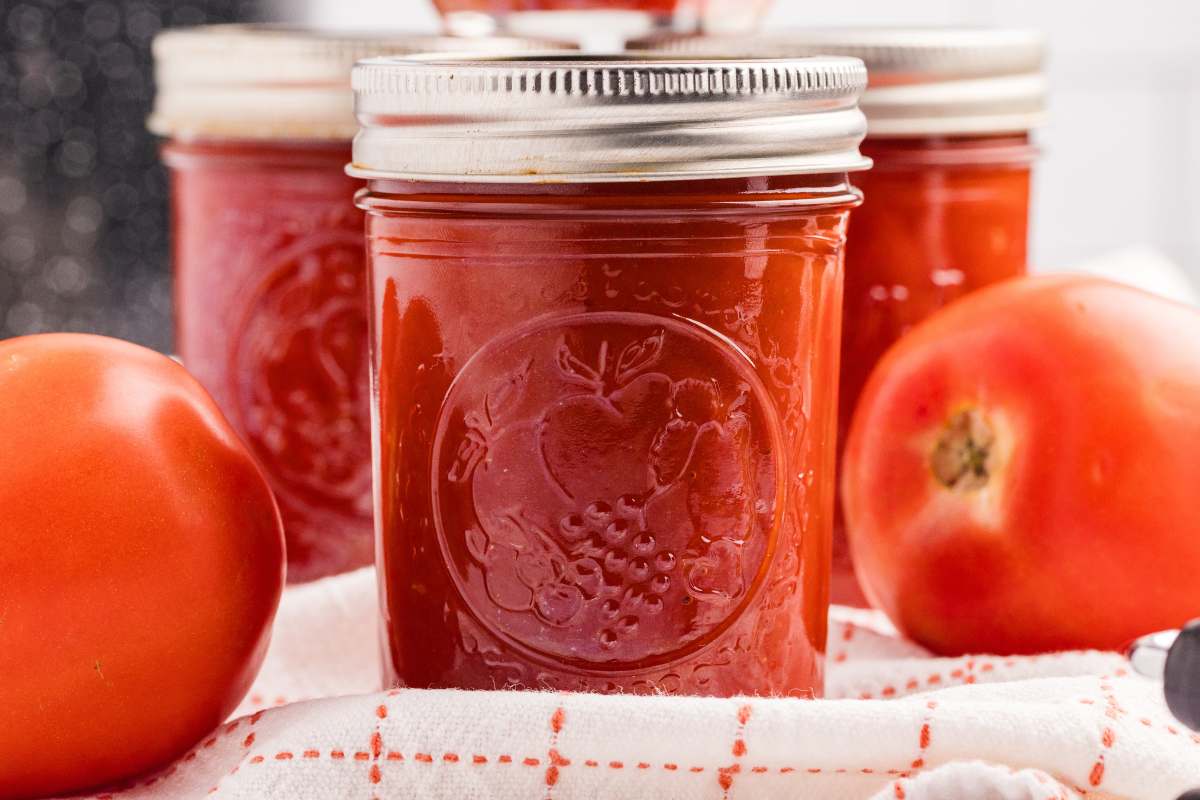There’s something deeply satisfying about making your own tomato paste.. This is my personal method, refined over many summers of trial and error, and it’s the one I rely on to stock my pantry every year. It’s not quick, but it’s simple, and the results are well worth the time. Let me walk you through exactly how to make it, step by step.

Every summer, I set aside one long, quiet day just for canning tomato sauce, and this is the exact recipe I’ve come back to, year after year. It takes all day but you won’t mind.
Ingredients and Tools You’ll Need
Super simple ingredients, but don’t skip the food mill! You’ll use it for lots of tomato recipes and it’s totally worth the investment.
Ingredients
- 14 pounds Roma tomatoes (in the case, I highly recommend a meaty, lower moisture tomato good for canning.)
- ⅓ cup bottled lemon juice (do not substitute with fresh lemon juice)
- 1½ tablespoons canning salt (optional, adds flavor but is not required for safety.)
Equipment

- Large stockpot
- Food mill (needed to remove skins and seeds, a strainer or blender won’t work for this!)
- Water bath canner
- Half-pint or pint canning jars with lids and rings
- Large bowl
- Ladle
- Basic canning accessories (funnel, jar lifter, debubbler, clean cloth)
How to Make Tomato Paste
Remember, all we’re doing is chopping, cooking, smoothing, cooking some more, putting in jars, and boiling the jars. Just take it one step at a time.
1. Start with very ripe Roma tomatoes
Roma or San Marzano tomatoes work best here—they’re dense, low-moisture, and full of flavor. You’ll need about 14 pounds, and yes, that’s going to look like a lot. Wash them thoroughly and roughly chop them. No need to be precise; everything will get cooked down and milled.

FREE FOR SUBSCRIBERS
Canning Binder
Subscribe (free!) to my newsletter to receive this PDF + dozens of others in my printable library. You’ll also get emails you’ll truly love, with a weekly meal and so much more.

If your tomatoes are on the juicy side, know that your simmer time will be longer.
2. Cook the chopped tomatoes down
Add the chopped tomatoes to a large stockpot and set it over medium heat. Stir often as they heat up—you don’t want any scorching at the bottom. Once they start to bubble, reduce to a simmer and cook uncovered for about 30 minutes. This step softens everything up before it goes through the food mill.

Don’t rush the boiling point. With this volume of tomatoes, it can take some time to get there.
3. Run everything through a food mill
This is where the transformation starts. Working in batches, run the softened tomatoes through a food mill to separate out the skins and seeds. You’ll be left with smooth tomato pulp—don’t skip this step or you’ll end up with a bitter, grainy paste.

A food mill is really the only tool that will do this job well. If you don’t have one, consider borrowing or investing.
4. Return the pulp to the pot and reduce
Pour the strained tomato pulp back into your cleaned stockpot. Now you’ll add the lemon juice and salt (if using). Bring it back to a gentle simmer, then turn the heat to medium-low. This is the long, slow part: simmer uncovered until the paste thickens deeply, anywhere from 2½ to 4 hours.

Watch for the “mounding on a spoon” moment, that’s your cue it’s thick enough. It should be glossy, dense, and almost scoopable.
5. Prepare your jars while the paste reduces
Wash your jars, lids, and rings in hot soapy water. Place the jars in your water bath canner, cover with water, and bring to a low simmer to keep them hot until you’re ready. You don’t need to sterilize them, but they do need to be hot when filled.
This is a good time to clean up a bit and set out your canning tools so everything’s within reach.
6. Fill the jars
When the paste is done, remove your jars from the canner and set them on a towel. Place your funnel in the jar and ladle in the hot paste, leaving ½ inch of headspace. The paste is very thick, so work slowly and neatly.

It helps to warm the ladle and funnel with a quick dunk in the hot canner water before filling—less sticking!
7. Debubble and wipe the rims
This is especially important with paste because trapped air bubbles are stubborn and thumping the jars on the counter won’t work. Use your debubbler tool or a clean chopstick to run around the inside edge. Tap the jars gently on the counter to help bubbles rise, then check your headspace again and adjust if needed.

Wipe the rims with a damp cloth to ensure a clean seal. Place the lids and rings on each jar and tighten to fingertip tight.

8. Process in a water bath
Lower them into the boiling water bath canner, making sure they are covered by at least 1 inch of water. Process for 45 minutes, adjusting for altitude if necessary.

You’ll need a full rolling boil the entire time, so don’t start the clock until it’s going strong.
9. Let the jars cool undisturbed
After the timer goes off, turn off the heat, remove the lid, and let the jars sit in the canner for 5 minutes. Then transfer them to a towel-lined counter and let them cool, untouched, for 12 to 24 hours.

Don’t rush this or move the jars around—it can interfere with sealing.
More Ways to Preserve Tomatoes
Once your tomato paste is done, here are a few more pantry staples worth trying:

Printable Recipe

Canning Tomato Paste
Equipment
- Cutting board and knife
- large stockpot
- Food mill
- large bowl
- Half-pint or pint mason jars
- lids and rings
- Ladle
- Canning funnel
- Debubbler
- Jar lifter
- Lid lifter (optional)
Ingredients
- 14 pounds Roma tomatoes
- ⅓ cup bottled lemon juice
- 1½ tablespoons canning salt optional
Save This Recipe
You'll join my email list which you will love. And if you don't, unsubscribe in one click. ❤️
Instructions
- Prep. Wash the tomatoes and roughly chop them. Add them to a large stockpot set over medium heat.
- Cook. Bring the tomatoes to a boil, stirring often to prevent sticking. Once boiling, reduce the heat to medium-low and simmer uncovered for 30 minutes, stirring occasionally.
- Mill. In batches, run the softened tomatoes through a food mill to remove skins and seeds. Discard solids or save for tomato powder.
- Reduce. Return the smooth tomato pulp to the pot. Stir in lemon juice and salt (if using). Simmer over medium-low heat for 2½ to 4 hours, or until the sauce reaches a thick, paste-like consistency. It should mound up on a spoon.
- Prep jars. While the sauce reduces, wash your jars and place them in the water bath canner. Cover with water and bring to a low simmer to keep the jars hot.
- Fill. When the sauce is ready, remove jars from the canner. Ladle the hot tomato sauce into hot jars using a canning funnel, leaving ½ inch headspace.
- Debubble. Use a debubbler or chopstick to release trapped air. Tomato paste is thick, so tap the jars gently if needed to help remove bubbles.
- Seal. Wipe rims with a clean damp cloth. Place on lids and screw on rings to fingertip tight.
- Process. Place jars into the boiling water bath, ensuring they’re covered by at least 1 inch of water. Process for 45 minutes for half-pints or pints.
- Cool. After processing, turn off the heat, remove the lid, and let jars sit for 5 minutes. Then remove jars to a towel-lined counter and let cool undisturbed for 12–24 hours.
- Store. Check for seals. Label, remove rings, and store in a cool, dark place for up to 18 months. Unsealed jars should be refrigerated and used within 3 days.
Notes
Nutrition


More to Explore
Hot Pepper Jelly Glazed Wings
Simple Homemade Marinara
How to Make Garlic Powder in a Dehydrator
Homemade Spiced Apple Rings (For Canning)